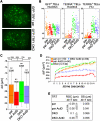Transcription regulates telomere dynamics in human cancer cells
- PMID: 22357912
- PMCID: PMC3312556
- DOI: 10.1261/rna.029587.111
Transcription regulates telomere dynamics in human cancer cells
Abstract
Telomeres are nucleoprotein structures capping the physical ends of linear eukaryotic chromosomes. Although largely heterochromatic, telomeres are transcribed into telomeric repeat-containing RNA (TERRA) molecules by RNA polymerase II. The functions associated with telomere transcription and TERRA remain ill defined. Here we show that the transcriptional activity of human telomeres directly regulates their movement during interphase. We find that chemical inhibition of global transcription dampens telomere motion, while global stimulation promotes it. Likewise, when DNA methyltransferase enzymes are deleted to augment telomere transcription, we observe increased telomere movement. Finally, using a cell line engineered with a unique transcriptionally inducible telomere, we show that transcription of one specific telomere stimulates only its own dynamics without overtly affecting its stability or its length. We reveal a new and unforeseen function for telomere transcription as a regulator of telomere motion, and speculate on the intriguing possibility that transcription-dependent telomere motion sustains the maintenance of functional and dysfunctional telomeres.
Figures






References
-
- Arora R, Brun CM, Azzalin CM 2010. TERRA: Long noncoding RNA at eukaryotic telomeres. Prog Mol Subcell Biol 51: 65–94 - PubMed
-
- Azzalin CM, Reichenbach P, Khoriauli L, Giulotto E, Lingner J 2007. Telomeric repeat containing RNA and RNA surveillance factors at mammalian chromosome ends. Science 318: 798–801 - PubMed
-
- Baird DM, Rowson J, Wynford-Thomas D, Kipling D 2003. Extensive allelic variation and ultrashort telomeres in senescent human cells. Nat Genet 33: 203–207 - PubMed
-
- Boyle S, Gilchrist S, Bridger JM, Mahy NL, Ellis JA, Bickmore WA 2001. The spatial organization of human chromosomes within the nuclei of normal and emerin-mutant cells. Hum Mol Genet 10: 211–219 - PubMed
Publication types
MeSH terms
Substances
LinkOut - more resources
Full Text Sources
